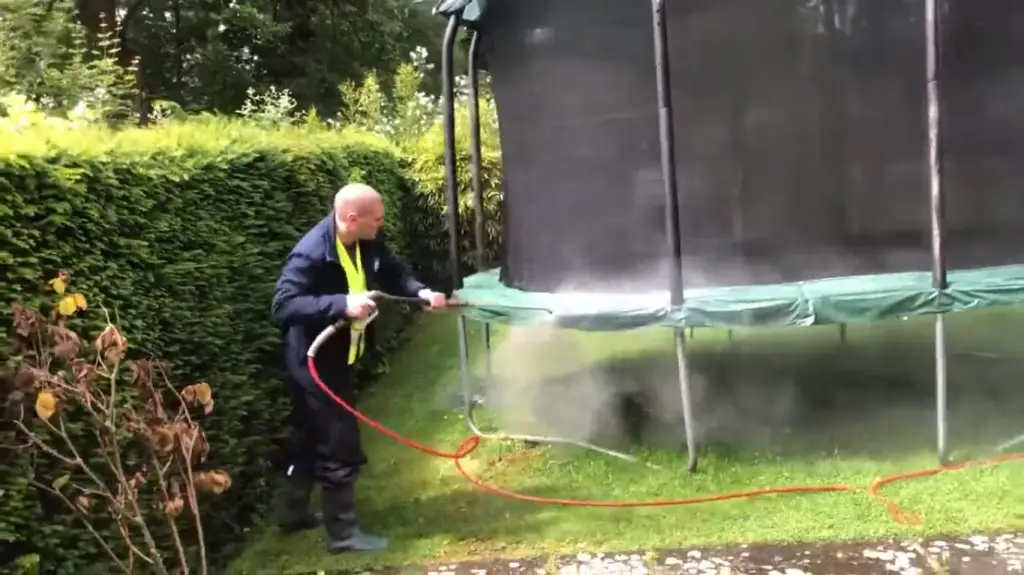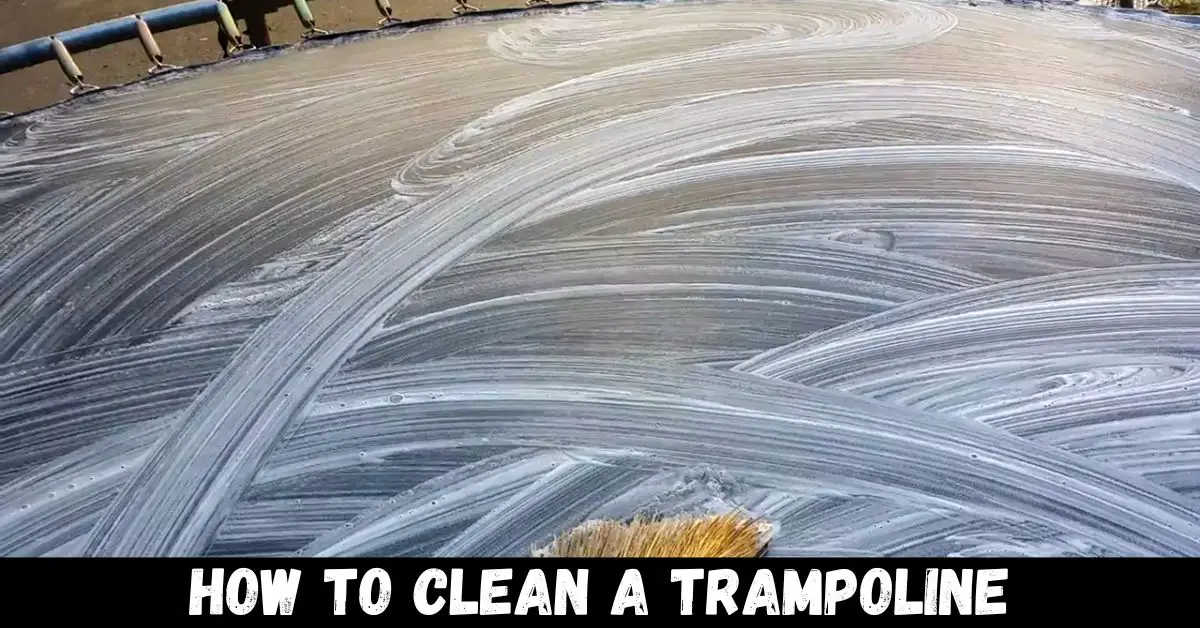When it comes to backyard fun, a trampoline is hard to beat. Bouncing on your trampoline is the perfect way to get fresh air and blast. But as much fun as jumping up and down can be, keeping your trampoline clean can seem overwhelming.
How to Clean a Trampoline? Cleaning your trampoline isn’t complicated, though, with the right accessories and supplies, you can eliminate dirt and debris in no time!
In this blog post, we’ll provide step-by-step instructions on properly cleaning your outdoor trampoline so that you can keep having safe family fun all summer long!
How to Clean a Trampoline? To clean a trampoline, remove debris, scrub the mat with a mild detergent, rinse, and let it air dry. Inspect the frame and springs. Use a trampoline cover for protection.
How to Clean a Trampoline? Easy Steps

Step 1: The trampoline should be swept off
Using the long brush, sweep away the larger debris from the trampoline surface. If your trampoline is equipped with springs, enlist someone to hold up the rim mat that covers them while you sweep off any dirt and debris trapped in the coils.
You may need to use a smaller brush or vacuum attachment to clean this area thoroughly. After completing the sweeping, inspect for any remaining debris and make sure everything is cleaned before allowing use.
Step 2: Fill a bucket with warm water and mild detergent and soak the mat
Once the surface is clear of debris, take a damp towel and wipe off any dirt or residue that may still be clinging to the trampoline. Then fill up a bucket with warm water and some mild detergent.
Use this solution to thoroughly clean the trampoline mat by dipping your sponge or soft cleaning cloth and wiping the mat’s surface.
Step 3: Scrub The Mat
Once the mat has been soaked, use a sponge or soft cleaning cloth to scrub away any dirt or residue that may still be clinging to the trampoline. Make sure you get into all corners and crevices to ensure that your trampoline is completely clean.
Step 4: Rinse off with a hose

Once you’ve scrubbed the mat, use a hose to rinse off any excess soap and dirt. Make sure you go over all the trampoline surfaces to ensure that it is completely clean before allowing anyone to get back on them.
Step 5: Wipe Down The Frame
Finally, take a dry towel and wipe down the frame of your trampoline to remove any remaining dirt. Please make sure you get into all the crevices to ensure no residue is left before allowing anyone back on it.
Step 5: Dry Your Mat
Once you’ve finished cleaning your trampoline, make sure that you let the mat dry completely before allowing anyone to jump on it. This will help to ensure that there is no moisture left behind, which can cause the springs and other parts of the trampoline to rust over time.
How to maintain my trampoline?
Maintaining your trampoline in good condition will ensure that it lasts as long as possible. Here are a few maintenance tips for caring for your trampoline:
- Inspect the mat and netting regularly to patch any rips or tears before they become too large.
- Clean the trampoline regularly to prevent dirt, dust, and debris from building up.
- Ensure that your trampoline is securely anchored with sandbags or other anchoring systems.
- Always use safety netting to minimize the risk of falls while jumping on a trampoline.
- Perform routine maintenance checks to ensure all springs and bolts are secure and properly tightened.
Weatherproofing and Protection
Here are some things for waterproofing and protection:
Using a Trampoline Cover to Prevent Debris Buildup
- Trampoline covers are specially designed to protect your trampoline from the elements and debris. They typically come in various sizes to fit different trampoline models.
- To use a trampoline cover, ensure that the trampoline is clean and dry. Shake off any loose dirt or debris.
- Place the cover over the trampoline mat, ensuring it’s securely fastened to the frame using elastic cords or hooks. Make sure the cover fits snugly.
- A trampoline cover acts as a shield against leaves, branches, bird droppings, and other debris that can accumulate on the mat. It also prevents UV exposure, which can cause the mat to deteriorate over time.
- Using a cover when the trampoline is not in use, especially during the off-season, will help keep it clean and prolong its lifespan.
Storing the Trampoline During Extreme Weather Conditions
- In regions prone to severe weather conditions like hurricanes, heavy snowfall, or thunderstorms, it’s advisable to disassemble and store the trampoline to prevent damage.
- Disassembling the trampoline typically involves removing the mat, springs, and frame. Refer to the manufacturer’s instructions for proper disassembly.
- Store the disassembled trampoline components in a safe and sheltered location, such as a garage or shed. Ensure they are kept dry to prevent rust and damage.
- Extreme weather conditions can cause the trampoline to become a safety hazard if left outside. Flying debris, strong winds, or heavy snow loads can damage or displace the trampoline, posing risks to both the trampoline and your property.
- Before disassembling and storing the trampoline, make sure to secure or tie down any loose objects and remove the trampoline’s safety net to prevent damage.
Taking these measures for weatherproofing and protection will help safeguard your trampoline against adverse weather and debris, ensuring it remains in good condition and safe for use.
Cleaning Trampoline Accessories
Now, we discuss accessories for cleaning the trampoline:
Cleaning and Inspecting Ladder and Anchor Kit
- Regularly clean the ladder that provides access to the trampoline. Use a soft brush or cloth to remove dirt, dust, and debris.
- Inspect the ladder for any loose or damaged parts. Tighten bolts and connectors as needed to ensure stability and safety.
- Ensure that the ladder’s non-slip steps are in good condition, as they play a vital role in preventing slips and accidents.
- For trampolines with anchor kits, check the condition of the anchors and the straps used to secure the trampoline to the ground. Ensure they are securely fastened and free from damage.
- Properly maintained ladder and anchor kits contribute to the overall safety and stability of the trampoline setup.
Checking the Condition of Any Added Features like Basketball Hoops or Tents
- If your trampoline is equipped with additional features such as basketball hoops, tents, or other attachments, it’s essential to inspect them regularly.
- Check the structural integrity of these accessories, ensuring that there are no loose or broken parts.
- For basketball hoops, verify that the hoop and backboard are securely attached and in good condition.
- Tents or enclosures should be checked for any holes or tears in the fabric and the condition of the zippers.
- Keep these attachments clean and free from debris, as neglecting maintenance can lead to wear and tear and potentially cause safety hazards.
- Ensure that any added features are installed according to the manufacturer’s guidelines and are safe for use.
Regularly cleaning and inspecting trampoline accessories, such as ladders, anchor kits, and additional features, is essential for maintaining a safe and enjoyable trampoline experience.
Addressing any issues promptly ensures that these components remain in good condition and contribute to the overall safety of the trampoline.
FAQs About How to Clean a Trampoline
Can you pressure wash a trampoline?
Not recommend. Pressure washing a trampoline can damage the mat and cause it to weaken over time. It is best to use a mild detergent and warm water to clean your trampoline, as this will not damage the mat or cause any other problems.
How often should you clean a trampoline?
It would help if you cleaned your trampoline at least once a month to keep it in good condition. You should also inspect the mat and netting periodically and patch any rips or tears as soon as they are noticed.
Should you oil the springs on a trampoline?
Oil the springs on a trampoline are not usually necessary as long as you ensure that all bolts and screws are properly tightened. If you decide to oil the springs, use a lubricant designed for trampolines to avoid damage.
Conclusion
In conclusion, knowing how to clean a trampoline is essential for both safety and longevity. Regular maintenance, such as removing debris, using a mild detergent for wet cleaning, and inspecting the frame and springs, keeps your trampoline in optimal condition.
Weatherproofing measures, like using a cover and storing the trampoline during extreme conditions, protect it from the elements. Additionally, cleaning trampoline accessories and checking their condition ensures a safe and enjoyable experience.
By following these steps and maintaining a routine, you’ll not only prolong your trampoline’s lifespan but also provide a safer environment for endless bouncing fun.
We hope you will be well aware of How to Clean a Trampoline, after reading this comprehensive article. If you have any questions, feel free to comment below!
Related Posts:

